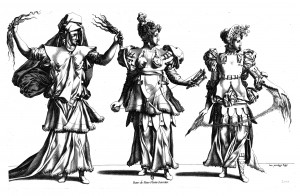Engraving by Pierre Milan, 25.7 x 42.3 P (Vienna). Inscribed at the bottom middle: Rous•de•Rous•Floren•Inuentor:, and at the lower right: Cum priuilegio Regis.
Fig.E.104 (Paris, Ed 3)
Robert-Dumesnil, VIII, 1850, 53-54, 90, as Boyvin; probably also Robert-Dumesnil/Duplessis, XI, 1871, 24, 4, as Boyvin. Le Blanc, 1854-1890, I, 507, 35, as Boyvin after Rosso. Levron, 1941, 75, 180, as Milan (see also 77, 228). Zerner, 1969, P.M.3.
COLLECTIONS: Cleveland, Museum of Art, 84.71; wm., a B, Briquet 8091 (from Hill-Stone, Inc., New York, Cat. no. 9, 1984, no. 23, Fig.). New York, 55.500.1 (a small etched bat has been pasted on the sheet between the middle and right figures). Paris, Ed 3 (trimmed, soiled); Ba 12, two impressions (the first trimmed at right and stamped at lower right: D. 3159; the second more trimmed); SNR. Vienna, F.I.3, p.29 bottom, no. 71 (on blue paper).
LITERATURE:
This print is very possibly the one mentioned by Vasari, 1568, II, 308 (Vasari-Milanesi, V, 433), as by Boyvin in the context of prints made by him from Rosso’s designs after his death: “alcune maschere fatte per lo re Francesco, simili alle parche.”
Kusenberg, 1931, 162, as Boyvin.
Linzeler, 1932, 182, as Boyvin.
Metman, 1941, 206, 212, 213, as by Milan and as done by 1545.
Barocchi, 1950, 94, 252, Fig. 231 (Paris), as Boyvin.
Oberhuber, 1966, 178, no. 300 (Vienna), as Milan, as also: Zerner, 1969, P.M.3; in EdF, 1972, 322, Fig. (Paris, Ed 3), 323, no. 421, and in Fontainebleau, 1973, I, 87, Fig. 58, II, 98, no. 421; Carroll, 1975, 25, 26, Fig. 13; Borea, 1980, 263, no. 684 (Vienna).
Lévêque, 1984, 2-3 (Fig., Paris, Ed 3, stamped D. 3159), as Milan after Rosso.
Marianne Grivel, in Ronsard, 1985, 83, no. 96 (Paris, Ed 3).
K. Wilson-Chevalier, in Fontainebleau, 1985, 171, under no. 113, as Milan after Rosso.
Delay, 1987, 64, 66-67, Fig. (Paris).
Carroll, 1987, 10, 43, 212-215, no. 68, with Fig. (Cleveland), and 216-217, no. 69, with Fig. (Vienna, on blue paper).
Brugerolles and Guillet, 1994, 108, under no. 37, as Milan after Rosso.
Mugnaini, 1994, 126, Fig.
Acton, in French Renaissance, 1994, 298-301, no. 71, Fig. (Paris, Ed 3).
The style of this image clearly supports the inscription, which gives the design of this print to Rosso; his authorship of the composition has never been questioned. Formerly thought to have been engraved by Boyvin, even, apparently, by Vasari in 1568, Metman has shown that it can be related to the 150 impressions of the “Parques masquées” by Milan that had been owned by Claude Bernard and which had been printed from a plate that he had obtained on 31 October 1545. There is no way of knowing how much earlier the plate may have been engraved.
On the basis of its style, Rosso’s design seems to have been made during the early period of his work on the Gallery of Francis I, or only shortly thereafter. It recalls the Loss of Perpetual Youth (P.22, II S) and the early composition of the Scene of Sacrifice (Fig.D.51). The Three Fates, Costume Designs may have been created about the same time as the Petrarch drawing of around 1534 (Fig.D.47a), to which its kind of invention seems related. The engraved image is probably shown in reverse of Rosso’s lost drawing, which, if meant to be read from left to right, would have shown the youngest Fate at the left and the oldest one at the right.
A lost drawing formerly in the collection of Baron V. Denon and described as representing the Three Fates and as by Rosso could be related to this print, although it could also be related to Milan’s other print after Rosso of this subject (Fig.E.105); it may, however, not be related to either.

